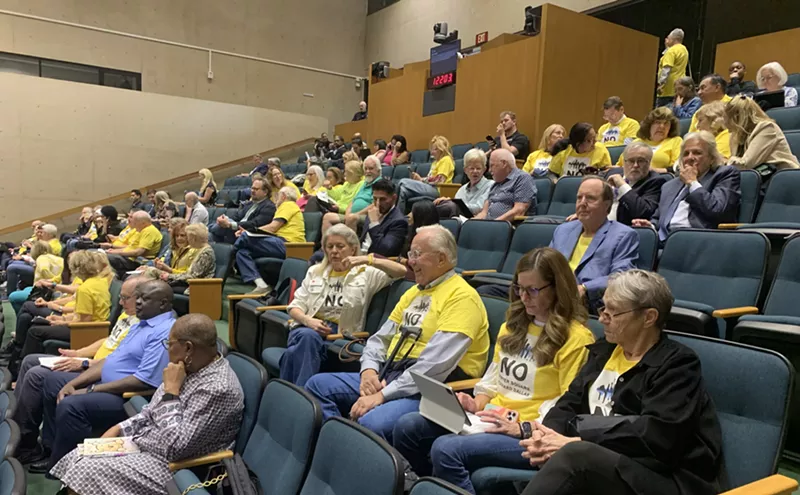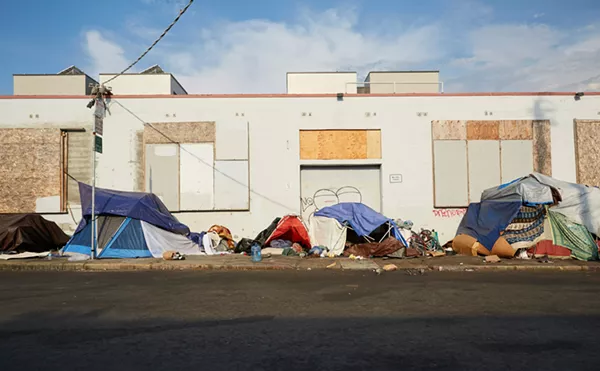I have been dealing with both the city and the U.S. Army Corps of Engineers in recent weeks seeking answers to questions about the "Dallas Wave" or "Standing Wave" man-made rapids that the city has installed in the Trinity River just downriver from downtown. It was intended to be a recreational attraction for a certain type of very specialized kayaking.
Last May, at just about the time the city had planned to open the Dallas Wave to the public, the city instead barred the public from using it because of some serious flaws that made it too dangerous. A side channel, intended to function as a safe passage for canoeists and other boaters, turned out to be too turbulent.
The thing also has soared in cost, from an original price of $1.5 million quoted to the city council by city staff at the outset several years ago to an amount of almost $4.3 million now, and that is before the cost of fixing the thing so it won't kill canoeists.
Some Friends of Unfair Park have been wondering why the city has to pay these additional costs if the original design was bad. Why isn't the designer responsible? City council member Angela Hunt has raised the same question with City Manager Mary Suhm. See her memo below.
The design thing turns out to be a more complicated issue than you might think. I'm going to talk about it in my column in next week's paper. I'm not even sure the thing was built according to a design.
In the meantime, I also had a number of questions for the U.S. Army Corps of Engineers, which controls the "floodway" portion of the river between the levees. The wave is right at the bottom (downriver end) of the levee system.
I wondered how the Dallas Wave got a corps permit in the first place, especially without any environmental impact study, since it's really a dam. It backs up the river for several miles, permanently flooding riparian wildlife areas that normally have wet and dry cycles.
Turns out it was easy. The corps simply ruled that the wave fell under the rubric of something called a "nationwide permit 42 for recreational facilities," meaning the wave did not need its own separate permit or environmental impact study. All the corps had to do was write a letter of permission.
I still have issues with that deal. If you look at the language for this type of national permit, it says: "No activity may cause more than a minimal adverse effect on navigation."
Right now, the Dallas Wave is an absolute bar and block to navigation of the river. The city has banned all navigation through it and has threatened to arrest at least one outfitter who was merely carrying canoes past it.
Yesterday evening the corps sent me a complete list of written answers that were responsive to my questions. But I do smell a bit of a dodge in one answer.
I asked: "The city has barred all public access to the river from the standing wave site or its environs and is about to bar access at the Sylvan River boat ramp for more than a year. What are the terms and conditions by which the city may bar access to a navigable river?"
The corps answered: "The City of Dallas should be contacted regarding restricted access to the Trinity River, as this is outside the jurisdiction of the Corps of Engineers."
I just don't think so. The terms of the nationwide permit seem clear. Impediments to navigation fall under the purview of the corps.
Charles Allen, the outfitter whom the city is now threatening to arrest, is trying to find a way to encourage the corps to take a more activist part in this problem. His main point is that the city should not be allowed to screw up the river for the vast majority of people who use it recreationally -- canoers -- in order to provide some fun for a tiny minority of people who engage in what's called "playboat" kayaking.
Playboats are little snub-nosed kayaks designed for doing tricks in white water, as opposed to paddling down a long length of river. There's nothing wrong with playboating, and it's a solid good for the river for anybody at all to get out there and use it for any recreational purpose. The more recreational use that can be documented, the stiffer the environmental standards the state must enforce on the river.
But think about putting this shoe on another foot. What if some private developer owned some riverbank land and wanted to build a water park of some sort that involved construction out in the river. Do we think for a minute that a private party would be able to bar navigation of the river for a year or more and then, even when construction was complete, render navigation considerably more difficult for people who were not the developer's clients?
The corps speaks bureaucratese. Sometimes it takes a translator to know what they really mean. If you look at their Answer No. 4 below, they may actually be hinting that they intend to take a more active role in getting this thing right. Or not. It's kind of like consulting the Ouija Board sometimes.
And then there is the money and design question. I said it was complicated. But it's still a good question. This thing didn't build itself. Somehow it's always easier to paper over a problem with tax money than it would be with private money. Back to my question about a private developer: You can damn well bet that any private party that had this kind of problem with a design would be thinking hard about how to get his money back.
If you're a real glutton for wonk-punishment or if you just can't get to sleep, you can read the corps' full responses on the next page. If you do, you will see that I misunderstood the type of modeling that the city is paying for the wave. I thought it would be a digital model. It's a physical model. Fortunately, this is the first mistake I have ever made about anything in my entire life including even neckties. My Q&A with the Corps
Why was no environmental impact statement done for the "Dallas Wave" standing wave water feature, a 6-foot dam at the downriver end of the Dallas Trinity River levee system? An environmental impact statement is required only for projects that have potentially significant environmental impacts. The "Dallas Wave" is not a Corps of Engineers project; therefore, the Corps of Engineers' review was conducted for two primary purposes: 1) to ensure the project did not adversely impact the ability of the existing Dallas Floodway to perform as designed. The criteria for this review, as outlined in the 1988 Record of Decision for the Trinity River and Tributaries, is primarily related to the 100-year and SPF (approximate 800-year) flood events; 2) to ensure compliance with regulatory requirements under Section 10 of the River and Harbors Act of 1899, and Section 404 of the Clean Water Act, which addresses proposed discharge of dredged or fill materials in waters of the U.S.
What permit was granted for this project? The project as presented in the permit application was verified to meet the conditions of Nationwide Permit 42, for Recreational Facilities with regard to Section 404 of the Clean Water Act, and a Letter of Permission was issued under Section 10 of the River and Harbors Act of 1899. Approval was also given under the requirements of the Trinity River and Tributaries, Record of Decision, as the project was determined to have no adverse impact, based on the information provided, on the ability of the existing Federal Dallas Floodway project to function as intended for a 100-year or SPF event and does not raise or lower the flood levels for either event.
Why did this project not require a variance or permit under the Corridor Development Certificate process mandated by the April 29, 1988, Record of Decision? The requirements of the Trinity River and Tributaries, Record of Decision, and the Corridor Development Certificate criteria administered through the North Central Council of Governments address the impact of projects on the 100-year and SPF flood events. The "Dallas Wave" project does not have an impact on the functioning of the Dallas Floodway system for these flood events.
The commander of the Fort Worth Division stated publicly earlier this year that the standing wave water feature at Dallas had been "modeled" by the corps. Does the corps believe that the feature now in place matches what was modeled? The Corps of Engineers reviewed the model and permit application submitted by the project designer for compliance with the criteria noted above, but did not develop an independent model. Current indications are that changes to the project as constructed may be necessary to meet the intended purpose as documented in the permit application. Any changes proposed by the project designer to ensure the project meets its intended purpose will again be reviewed by the Corps under these criteria. The Corps didn't model the Standing Wave; however, the Corps did review the City consultant's model. Any future modifications will be reviewed as appropriate.
The city of Dallas is about to spend $76,000 to have the existing feature digitally modeled. Will the city have access to the model commissioned by the Corps? The city is spending $76,000 to have a physical model of the Standing Wave so that they can literally see how the wave with behave at various flow rates. The Corps has no involvement in the physical model. If design changes are made based on the physical model's behavior, then a hydraulic computer model will be developed by the City consultant. The Corps will review these as appropriate.
The city has barred all public access to the river from the standing wave site or its environs and is about to bar access at the Sylvan River boat ramp for more than a year. What are the terms and conditions by which the city may bar access to a navigable river? The City of Dallas should be contacted regarding restricted access to the Trinity River, as this is outside the jurisdiction of the Corps of Engineers.












